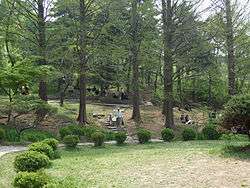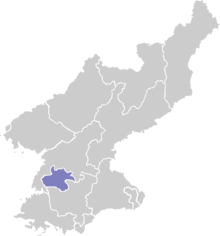Moranbong-guyok
Moranbong-guyŏk (Korean: 모란봉구역), or the Moranbong District, is one of the 18 guyŏk which constitute the capital city of Pyongyang, North Korea. It is located north of Chung-guyok, the city's central district, and is bordered to the north by Sosong and Taesong-guyoks, to the east by the Taedong River, and the west by the Potong River and Potonggang-guyok. It is named after Moran Hill located in the district's west area ("Moran" is Korean for 'peony'). It was designated a guyŏk in October 1960 by the Pyongyang City People's Committee.
Moranbong-guyŏk | |
|---|---|
Guyŏk of Pyongyang | |
| Korean transcription(s) | |
| • Hangul | 모란봉구역 |
| • Hanja | 牡丹峰區域 |
| • Revised Romanization | Moranbong-guyeok |
| • McCune–Reischauer | Moranbong-guyŏk |
 Moranbong Hill | |
| Country | North Korea |
| Direct-administered city | P'yŏngyang-Chikhalsi |
| Administrative divisions | 15 administrative dong |
Overview
A large part of the district is taken up by the Moranbong Park, Pyongyang's largest recreation area, which contains historic relics, including vestiges of the old Pyongyang Castle walls and various ornamental pavilions.[1] The district is also home to the Kim Il-sung Stadium and the site of Kim's first speech after the liberation of Pyongyang on 14 October 1945,[2][3][4] called "Every Effort for the Building of a New Democratic Korea".[4] The Pyongyang Arch of Triumph, the world's largest such arch, is also located in the district.[2]
Transport
The Pyongyang Metro runs through this district, with stops at Tongil, Kaeson, Chonu, and Chonsung stations.[5] It is connected to Rungra Island and Taedonggang-guyŏk (on the Taedong's left bank) by the Rungra Bridge.[6]
Administrative divisions
Moranbong-guyok is divided into fifteen administrative districts known as dong. The largest neighborhoods (Inhung, Pipa, and Kinmaul) are further divided in two parts for administrative purposes.[7] Inhung District is the home of North Korea's State Administration of Quality Management.[8]
| Chosŏn'gŭl | Hancha | |
|---|---|---|
| Changhyŏn-dong | 장현동 | 長峴洞 |
| Ch'ilsongmun-dong | 칠성문동 | 七星門洞 |
| Chinhŭng-dong | 진흥동 | 進興洞 |
| Chŏnsŭng-dong | 전승동 | 戰勝洞 |
| Chŏn'u-dong | 전우동 | 戰友洞 |
| Hŭngbu-dong | 흥부동 | 興富洞 |
| Inhŭng-dong | 인흥동 | 仁興洞 |
| Kaesŏn-dong | 개선동 | 凱旋洞 |
| Kimmaŭl-dong | 긴마을동 | 長村洞 |
| Minhŭng-dong | 민흥동 | 民興洞 |
| Pip'a-dong | 비파동 | 琵琶洞 |
| Puksae-dong | 북새동 | 北塞洞 |
| Sŏhŭng-dong | 서흥동 | 西興洞 |
| Sŏngbuk-tong | 성북동 | 城北洞 |
| Wŏlhyang-dong | 월향동 | 月香洞 |
References
- "Cultural Heritage of North Korea" (in Korean). National Research Institute of Cultural Heritage. Archived from the original on 19 December 2013.
- Corfield, Justin (2014). "Moranbong". Historical Dictionary of Pyongyang. London: Anthem Press. p. 146. ISBN 978-1-78308-341-1.
- Mintjens, Ronny (2013). A Journey through North Korea. Trafford Publishing. p. 55. ISBN 978-1-4907-0176-9.
- Dae-Sook Suh (1981). Korean communism, 1945–1980: a reference guide to the political system. University Press of Hawaii. p. 27. ISBN 978-0-8248-0740-5. Retrieved 7 July 2015.
- Bone, Simon. "Maps". The Pyongyang Metro. Archived from the original on 26 October 2017.
- "Doosan Encyclopedia". Encyber.com (in Korean). Retrieved 2 July 2010.
- 중앙일보 - 아시아 첫 인터넷 신문. Nk.joins.com (in Korean). Retrieved 15 December 2017.
- "Euro-Asian Cooperation of National Metrological Institutions". Moscow: CooMet Secretariat. 27 August 2013.
